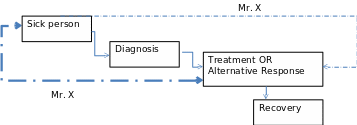Setting Protocols
The case analyzed in this essay points out the insufficiency of protocol and ignorance by staffs on how to manage a psychiatric emergency. Concisely, the emerging issues are; failure to conclude a case; staffs failure to clear case vagueness or pass amendments to the next staff in charge; and lack of information on how to deal with undiagnosed or misdiagnosed patients (Saxena, Ramer, & Shulman, 2004). Staffs need to know how to cope with psychiatric emergencies. This exercise will improve the staffs understanding on the emergency. Thus, the staffs will be capable of playing their respective roles in attending to the psychiatric crisis.
Possible Causes
The current protocol is rigid. It offers staffs two-way options without the probability of accommodating nonstandard cases. This is a weakness. In the case of Mr. X, which was presented in the case study, there appears to be no provision for staffs to incorporate their rationality. Mr. X’s, condition falls outside of their ordinary behavioral expectations of patients. The irrational following of current protocol was a weak point in the case study. If it were not for following protocol, perhaps the police would have cared to present Mr. X back to hospital, for further diagnosis. However, following their protocol of dealing with such people, they saw no motive and therefore left Mr. X alone. Another weakness of the process is the mishandling of Mr. X, which arose because the case was not closed.
The presented case caused a variation in the normal tackling of patients by the staffs because it had no parameters to capture, at initiation (Roesser, 2007). Mr. X lacked all common symptoms of illnesses observed by staffs. Secondly, he behaved in a manner that triggered the attention of the Rapid Response team, yet there was no diagnostic conclusion to aid in their response. As the cause – effect diagram below shows, Mr. X’s condition failed to satisfy necessary points in the current protocol. Thus, he skipped diagnosis and recovery and would keep doing that until a change to the protocol occurs.

Improvement Plan
Staffs follow protocol; however, they also need to make rational choices in the event that protocol does not provide for a proper reaction to the patient’s condition.
The patient first engagement with the hospital staffs need to be improved. There should be a provision for the patient to divulge any prior characteristics of his health condition. Staffs need an additional action steps to use when all necessary tests, done at the preliminary stages of diagnosis, turn negative. The current protocol lacked a provision to hold the patient for observation. There is need to regulate staffs reaction to abnormal patient behavior. Medical specific reference, by staffs, has to transpire outside the patient’s presence, unless they are direct communications to him or her. Unsolved cases must be booked for additional tests and observation.
Currently, the staffs at various departments understand the present protocols and obey them. Patients coming to the hospital receive various diagnostic tests to verify their kind of illness. The staffs do a commendable job of dealing with all cases, which arise, as per protocol directives. It itself, the present protocol as presented in the case study is functioning well. Nevertheless, in accordance with the FOCUS-PDCA model, the current protocol setting lacks the necessary functions that would make it adaptive and sustainable (Stoltz, 1996).
Improvement: Unit Protocol
The proposed team will consist of receptionists at the hospital and at the ward. Other members, involved at later stages are physicians and their assistants, ICU nurse in charge and unit staffs. The rapid response team will also play a part, when needed. The proposed unit protocol will aim at fixing the loopholes of the current system. Therefore, it will add an additional requirement for staffs to follow.
First, front staffs dealing with the patient at first appearance must capture all details pertaining to the patient. Second, they would then pass all those details, even if they do not fit into the profile sheet to the next staff in charge. The details would aid additional observation and diagnosis in case of a behavioral emergency. Third, at diagnosis and after diagnosis, all emerging information is shared, in real-time with the rapid response unit. Fourth, all staffs remain ready to react rationally based on skills, knowledge and experience and refrain from letting their emotions cause a misjudgment of situations. Fifth, during and after behavioral emergencies, staffs note the missing points of the current protocol, for future ratifications.
Measurement
To check if the new protocol works, the staffs would create a mock behavioral emergency and use the new protocol to attend to it. Next, management would create an almost real emergency without the knowledge of the staffs, and observe if the previous mock emergency influence the adaptability to the current one (Saxena, Ramer, & Shulman, 2004). Each staff department would provide feedback on how the new protocol allowed them to cope with the behavioral emergency. The feedback would offer a benchmark for comparison with previous protocols.
References
Roesser, K. (2007). Decreasing the risk of chemotherapy errors through a failure modes and effects analysis (FMEA) and a FOCUS PDCA (Plan, Do, Check, Act) Quality improvement model. Oncology Nursing Forum, 34(2), 510-510.
Saxena, S., Ramer, L., & Shulman, I. A. (2004). A comprehensive assessment program to improve blood-administering practices using the FOCUS–PDCA model. Transfusion, 44(9), 1350-1356.
Stoltz, P. K. (1996). Today’s Management Methods: a guidance for health care executives. In R. G. Gift, & C. F. Kinney, Today’s management methods: a guidance for health care executives (pp. 223-244). Minneapolis, MN: University of Minnesota.